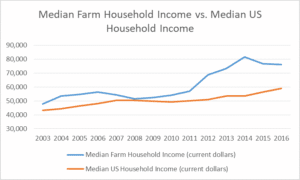The notion that businesses involved in agriculture have been losing for the last 15 years can only come from someone who hasn’t been involved in agriculture for the last 15 years.

Agricultural businesses have seen an increase in their income over the years. Economic expansions, increased efficiencies, and opening of new markets all led to increased income and profits. There is always volatility within agriculture, and individual businesses or even regions can have differing year-to-year success, but by and large, the agriculture sector has done well.
In fact, the sector has done better on average than the rest of the country. For example, when the Great Recession of 2008 saw nearly $3 trillion wiped form the economy, the agriculture sector was soaring. This trend has resulted in households with income from farming fast outpacing non farming households.
Businesses involved in agriculture face a number of headwinds. In the last couple of years, prices for most commodities have come down from repeated record or near record highs experienced from 2009-2013 and settled at a level much closer to the long-term average price. Costs of production have not dropped as much, though USDA predicts they will go down 0.8 percent in 2018 on top of a 0.3 percent drop in 2017. And more and more farmers are finding out that their success at growing more crops per acre with fewer and fewer resources is leading to a glut of product. The problem facing much of farm country isn’t that they don’t have crops, it’s that they have a bigger harvest than they can handle and they need to expand existing markets or find new markets for their products.
That’s why there is no greater threat to American agriculture than a trade war. This is especially critical for soybean producers. Soy has actually been the outlier amongst most commodities. Prices have stayed high enough to not trigger payments under government support programs. Since 2014, corn has received nearly $10.9 billion in ARC/PLC payment while soybeans received $1.6 billion since 2014. Wheat has received $3.4 billion, peanuts has received nearly $1.4 billion, and long-grain rice has received nearly $1.7 billion since 2014. For the first time on record there are now more acres planted to soy than to any other crop, including king corn.
However, soybeans have suffered dramatically due to the trade war between the US and China, with soybean futures plummeting nearly 20 percent.
This is 100 percent due to the Trump administration undertaking a trade war and the Chinese government’s imposition of retaliatory actions. When 53 percent of your crop is exported (over half of that to China), cutting off markets will decimate businesses. That’s why analysts have estimated imposition of a 25 percent tariff could cost soybean producers as much as $1.4 billion to $7.7 billion in sales if these ill-advised trade actions are not reined in.
Lawmakers in Washington should fight to dismantle manipulative, trade distorting barriers to free trade wherever they are found. But the president’s misrepresentation of the experience and success of American farming households over the last 15 years, in order to deflect attention from the damage this trade war of choice is inflicting on farm country, is plain irresponsible.














Get Social